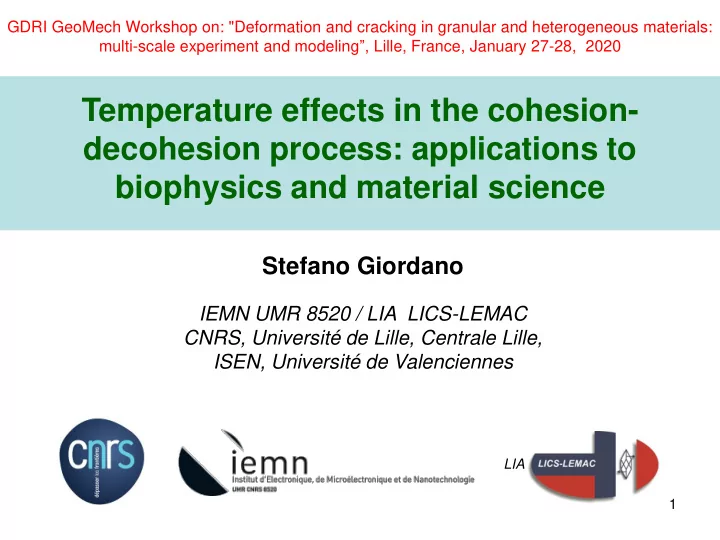

GDRI GeoMech Workshop on: "Deformation and cracking in granular and heterogeneous materials: multi-scale experiment and modeling ”, Lille, France, January 27-28, 2020 Temperature effects in the cohesion- decohesion process: applications to biophysics and material science Stefano Giordano IEMN UMR 8520 / LIA LICS-LEMAC CNRS, Université de Lille, Centrale Lille, ISEN, Université de Valenciennes LIA 1
Cooperations Giuseppe Puglisi Full Professor at Polytechnic of Bari, Department of Civil Engineering Sciences and Architecture Manon Benedito Pier Luca Palla PhD student at Institut MdC at Institut d'Électronique de d'Électronique de Microélectronique et Microélectronique et de Nanotechnologie de Nanotechnologie IEMN - UMR 8520, IEMN - UMR 8520, Centrale Lille Université de Lille 2
Context: study of mechanical microinstabilities (conformational transitions or ruptures) in small systems with important effects of the temperature Method: combination of statistical mechanics with Micro/nano Statistical micro/nano mechanics to mechanics mechanics approach a broad range of applications Biophysics Material science 3
Adhesion in biology K. Autumn, N. Gravish, Gecko adhesion: evolutionary nanotechnology, Philosopical Transaction of the Royal Society, 2008. Xuan Cao et al. Proc Natl Acad Sci U S A. 114 (23): E4549-E4555 (2017) 4
Nanomechanics of macromolecules Single molecule force spectroscopy TIBS 24, p. 379 – 384, 1999 5
Hairpins Phase transformations unzipping in shape memory alloys Physics Reports 631 (2016) 1-41 Composites Part B 86 (2016) 285-298 6
Adhesion/deadhesion in micro-nano technology… R Villey, et al., Soft Matter, 11, 3480-91 (2015) …treatment of old …glaciology …geology paintings JAIC 1992, Volume 31, Number 2, Crevasse, Emmons Glacier, Crevice, Wyoming 7 Article 2 (pp. 161 to 173) Washington
Fracture mechanics Plastic phenomena 8 Portevin Le Chatelier effect Luder band
Taxonomy of microinstabilities Bistable (or multistable) behavior between one ground state and one (or more) metastable state . Examples: conformational transitions in polymers or martensitic transformations in solids. Transitions between the broken or unbroken states of some breakable units of the system. Examples: unzipping of hairpins, denaturation of macromolecules and peeling of films. 9
Model of cohesion-decohesion Breakable ! Intact elements Broken elements Intact elements Broken elements Helmholtz ensemble Gibbs ensemble ( prescribed position ) ( applied force ) Equilibrium statistical mechanics (rate-independent process) Application to : Hairpins unzipping and Strength of materials 10
Hypothesis: zipper model Applied force or prescribed extension +1 N 0 Broken elements Intact or unbroken elements Position of the domain wall Hypothesis: absence of “bubbles” between the two corresponds to a single domain wall regions moving with mechanical actions and temperature 11
Ratio between Vertical positions Number of intact elastic constants of the elements elements Potential energy of the system is a tridiagonal matrix and Where with 12
Properties of where 13
Helmholtz ensemble Progressive ( prescribed position ) or gradual breaking Partition function Average number of intact (or unbroken) elements Average value of the force Temperature- dependent force plateau 14
Gibbs ensemble ( applied force ) Partition function Simultaneous or cooperative Average number of intact breaking (or unbroken) elements Average value of the extension Temperature- dependent force plateau 15
Thermodynamic limit ( N →∞ ) (asymptotic methods) Solid lines: Helmholtz Phase transition Dashed lines: Gibbs with 16 Critical force Critical or denaturation temperature
Force-spectroscopy methods (Neuman and Nagy, 2008) Atomic force Magnetic tweezers Optical tweezers MEMS microscope Devices with variable stiffness k c (10 −5 - 10 4 pN·nm −1 ) Equivalent Stiffness k c Soft cantilever → Gibbs ensemble Hard cantilever → Helmholtz ensemble
Detachment Hairpins experiment Optical tweezers 18
Hairpins S. de Lorenzo, M. Ribezzi-Crivellari, J. R. W. Stephenson, S. Keller, R. Santiago, J. E. Albrecht, P. Arias-Gonzalez, S. B. Smith, and F. Ritort, N. Asare-Okai, S. A. Tenenbaum, M. Zuker and Pan T. Biophysical Journal 108, 2854 (2015). X. Li, Phys. Chem. Chem. Phys. 16, 906 (2014). Model with 3 parameters! 19 R. B. Wallace, J. Shaer, R. F. Murphy, J. Bonner, T. Hirose, K. Itakura, Nucleic Acids Res. 6, 3543 (1979).
Generalization with softening 20
Hypothesis: extension of the zipper model Applied force or prescribed extension +1 +1 0 N Partially Completely broken Intact or unbroken broken elements elements elements Position of the two domain walls Hypothesis: absence of “bubbles” between the three corresponds to a couple of domain regions walls moving with mechanical actions and temperature 21
Vertical positions Ratios between of the elements elastic constants is a tridiagonal matrix and Where with 22
Properties of 23
Force-temperature behavior = 24
Phase diagram 25
Dislocation nucleation at high temperature before cracking 26
27
Experimental results 28 Comparison with theory
Conclusions • The combination of statistical mechanics and nano- micromechanics allows for studying the behavior of systems in large temperature intervals and over a wide range of sizes (from the nanoscale to the macroscale). • Moreover, we can approach problems pertaining to rather different topics, spanning soft matter, biophysics, mechanics of adhesion, fracture mechanics, material science and so on. • To conclude, some perspective concerns the study of the dynamics (out-of-equilibrium statistical mechanics) and the effect of the heterogeneity in systems with microinstabilities. 29
THANK YOU FO FOR YOUR ATTENTION ! JCP 137, 244907 (2012) JCP 136, 154906 (2012) PRE 87, 032705 (2013) Phys. A: Stat. Mech. Appl. 395, 154 (2014) PRL 113, 255501 (2014) EPJE 38, 44 (2015) Eur. J. Mech. A/Sol. 60, 145 (2016) Main publications: Annalen der Physik 528, 381 (2016) Microsystems & Nanoengineering 2, 16062 (2016) Soft Matter 13, 6877-6893 (2017) Continuum Mechanics and Thermodynamics 30, 459 (2018) JCP 149, 054901 (2018) PRE (Editors' Suggestion) 98, 052146 (2018) EPJB 92, 174 (2019) Inventions 4, 19 (2019) Phys. Lett. A, 10.1016/j.physleta.2019.126124 (2019)
Recommend
More recommend